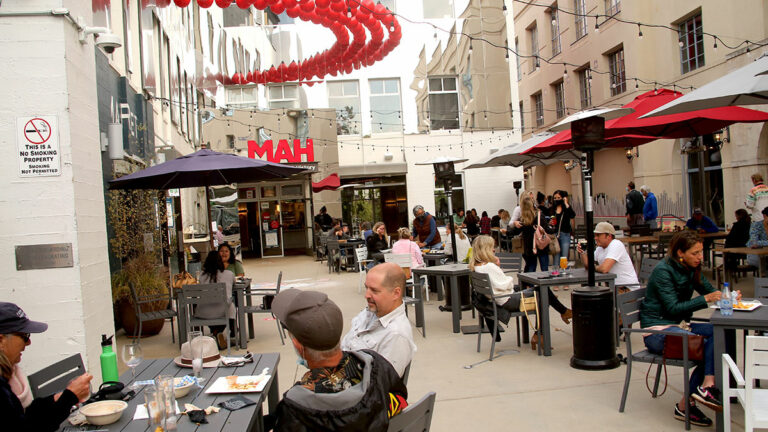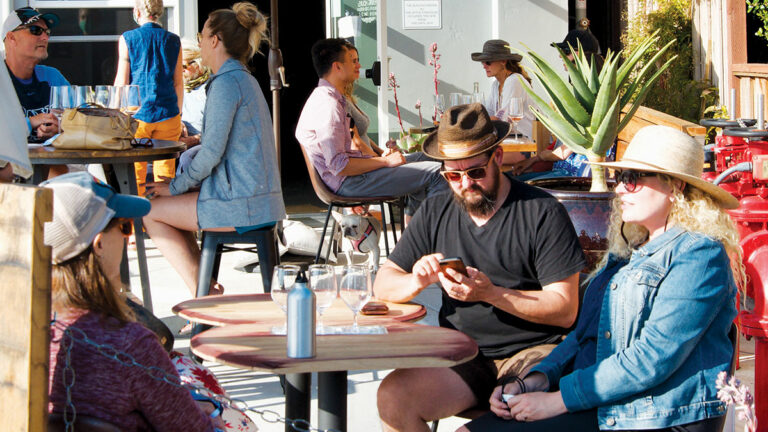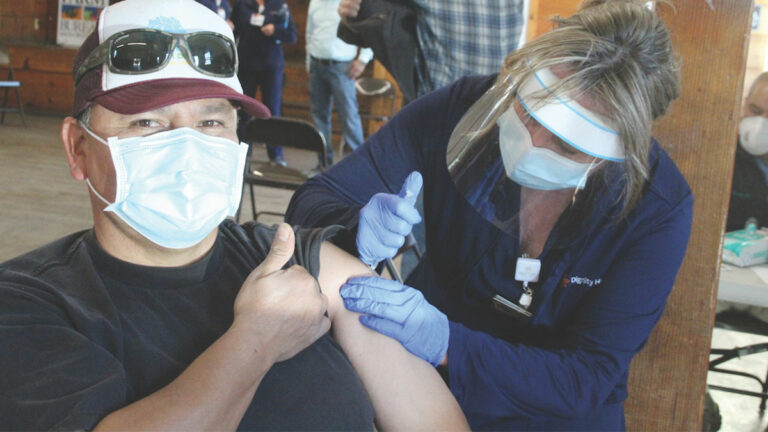This guide is part of Explore Santa Cruz 2021.
AMERICAN
515 Kitchen & Cocktails
515 Cedar St., Santa Cruz, 831-425-5051, 515santacruz.com
One of the best places for cocktails, where mixologists work with loads of ingredients (have you ever seen so many types of bitters?) and present a dizzying array of house recipes. Small plates as well as dinner entrées are thoughtfully crafted in this creatively designed venue. Cool staff and patrons.
Alderwood
Located in downtown Santa Cruz, Alderwood is a coastal steakhouse with dining-room, bar and chef’s-counter seating.
Aptos St. BBQ
8059 Aptos St., Aptos, 831-662-1721, aptosstbbq.com
Aptos St. BBQ has a few recipes for success: sweet and smoky barbecue sauce, a large craft beer list, a roadhouse vibe, mouthwatering Texas-style tri-tip, hot links, ribs, and more.
Avenue Cafe
427 Capitola Ave., Capitola, 831-515-7559
This neighborhood restaurant in a quaint Capitola cottage is a great place to meet family and friends for a delicious traditional breakfast or lunch. Patrons line up to enjoy the award-winning Eggs Benedict.
Back Nine Grill & Bar
555 Hwy. 17, Santa Cruz, 831-423-5000, backninegrill.com
Inspired by rich local history—the restaurant sits adjacent to Pasatiempo Golf Club designed by Alister MacKenzie in 1929—and the style of food preparation dating back to Rancho Carbonero Mexican Land Grant on which the land now resides.
Beach Hut Deli
Delicious hot and cold sandwiches, salads and snacks with a tiki vibe.
Bittersweet Bistro
787 Rio Del Mar Blvd., Aptos, 831-662-9799 bittersweetbistro.com
American bistro cuisine with Mediterranean influences features a special emphasis on local and organic produce.
Bruno’s Bar and Grill
230 Mt. Hermon Road, Scotts Valley, 831-438-2227, brunosbarandgrill.com
American bar and grill with a bottomless mimosa brunch and a famous, big Bloody Mary that includes too many toppings to list here, but it is a work of art—think Leaning Tower of Pisa—that will not leave you hungry or thirsty.
The Buttery
702 Soquel Ave., Santa Cruz, 831-458-3020, butterybakery.com
This beloved bakery has it all, plus a loyal crowd to prove it. They show up for cakes, pies, tarts, cookies, plus creative sandwiches, hot breakfast items and so much more.
Café Cruz
2621 41st Ave., Soquel, 831-476-3801, cafecruz.com
One of the most successful restaurants in the area, Café Cruz stands out for its commitment to serving reliably delicious, locally and sustainably sourced cuisine in a lively atmosphere. Coupled with a superior wine list, this is a culinary haven.
Café Gratitude
103 Lincoln St., Santa Cruz, 831-427-9583, cafegratitude.com
A “plant-based” culinary romp. Fresh, organic food is served at this unique eatery. After sampling its vast list of vegetarian treats and drinks, and its inventive food creations, you’ll want to take home a cookbook.
Café Rio
131 Esplanade, Aptos, 831-688-8917, caferioaptos.com
This restaurant on the beach is a great date night spot with romantic views, delectable seafood and filet mignon. Across the courtyard, you’ll find their casual spot, Flats Bistro, for artisan pizza, gourmet coffee and more.
Chill Out Café
860 41st Ave., Capitola, 831-477-0543
Known for its breakfast burritos—20 to choose from—plus sandwiches, salads and smoothies, this Pleasure Point beach shack serves breakfast all day and evening, plus a good selection of espresso drinks that you can enjoy on the garden patio.
Crepe Place
1134 Soquel Ave., Santa Cruz, 831-429-6994, thecrepeplace.com
The Crepe Place has been serving a giant selection of delectable crepes since 1973. A locals’ favorite, they also dish up enormous salads and weekend breakfast. The outdoor garden and an extensive selection of single malts also make this place stand out.
Crow’s Nest
2218 East Cliff Drive, Santa Cruz, 831-476-4560, crowsnest-santacruz.com
This very popular restaurant in the Yacht Harbor wins points for its large menu of fresh seafood, steaks, chicken, and appetizers—but it’s known for excellent service and incredible views.
Davenport Roadhouse
From breakfast to lunch and dinner, this tasty restaurant in the seaside town of Davenport is well worth the gorgeous 10-minute drive up Highway 1 from Santa Cruz.
East End Gastropub
1501 41st Ave., Capitola, 831-475-8010, eastendpub.com
This refreshingly refined sister of West End Tap offers new American dishes that match well with the house craft beer. Creative takes on pizza, burgers, salads, and entrees like pork belly and strip steak.
Erik’s DeliCafe
See all locations at eriksdelicafe.com/locations
Sandwiches, salads and soups.
The Grille at Delaveaga
401 Upper Park Road, Santa Cruz, 831-423-1600, delaveagagolf.com/dining
The newly renovated, award-winning restaurant offers continental and California cuisine featuring carefully sourced ingredients from many local and organic farms. Enjoy the stunning views, cozy built-in fireplace, full bar, outdoor patio and deck seating.
Heavenly Roadside Cafe
1210 Mt. Hermon Road, Scotts Valley, 831-335-1210, heavenlyroadsidecafe.com
A casual place to find modern takes on classic favorites made with fresh ingredients. Breakfast options abound, or stop in for their John Wayne burger topped with bbq sauce and housemade onion rings from their burger bar.
Hindquarter Bar & Grille
303 Soquel Ave., Santa Cruz, 831-426-7770, thehindquarter.com
Hindquarter’s Smoky Platter has a bit of everything, including Chicago baby back ribs. Aged Angus top sirloin steaks, catch-of-the-day fish, live Maine lobster, pastas, burgers and steak-cut french fries are the restaurant’s specialties. Meats are house-smoked.
Hollins House
An elegant dinner house at the Pasatiempo Golf Course, the 1930’s building is filled with earthy charm. On a cool night, enjoy a drink by the fireplace before settling in to your table, or on a warm night relish the views of the Monterey Bay from the outdoor patio.
Holy Smokes Country BBQ
This popular caterer has opened a restaurant in East Cliff Village. Enjoy your favorite ribs, brisket, chicken, and more.
Home
3101 N Main St., Soquel, 831-431-6131, homesoquel.com
In charming Soquel Village, Home serves up the finest local, seasonal veggies and local meats prepared by talented Chef Brad Briske.
Ideal Bar & Grill
106 Beach St., Santa Cruz, 831-423-5271, idealbarandgrill.com
Fish, steaks and pasta dishes shine at this venue, where you can reach out and almost touch the sand. A fun, you’re-on-vacation scene prevails. There’s salsa dancing on the patio if your timing is right.
Iveta Cafe
2125 Delaware Ave., Santa Cruz, city, iveta.com
Offering all-natural artisan baking mixes and freshly prepared meals that recall the European-style cafes.
The View at Chaminade
1 Chaminade Lane, Santa Cruz, 831-475-5600, chaminade.com
At one of the more dramatic views, The View brings the local agricultural bounty to your plate accompanied by wines of the Central California Coast. Live music every week featuring local artists from around Santa Cruz, the Central Coast and Bay Area.
Malone’s Grille
4402 Scotts Valley Drive, Scotts Valley, 831-438-2244, malonesgrille.com
Burgers, steaks, cocktails, and karaoke. Enough said.
MacKenzie Bar & Grill
18 Clubhouse Road, Santa Cruz, 831-459-9162, pasatiempo.com
Enjoy a picturesque setting for breakfast or lunch near a fireplace, or with a view of the Monterey Bay. Post-golf drinks and appetizers are especially pleasant on the veranda near Pasatiempo’s ninth green. Breakfast is served all day.
Michael’s on Main
2591 S. Main St., Soquel, 831-479-9777, michaelsonmain.net
Cutting-edge comfort food with classics such as Yankee Style Pot Roast are featured alongside well-done dishes, like Braised Short Ribs. The bar is a popular spot to catch live music, and they have a new tap room to keep the good times flowing.
Oswald
121 Soquel Ave., Santa Cruz, 831-423-7427, oswaldrestaurant.com
One of the area’s finest restaurants. From fresh seafood entrées to fine meats, Oswald does everything well and tastefully. The presentations, decor and excellent wine list all add up to a memorable meal—and evening.
Paradise Beach Grille
One of the best restaurants in Capitola, this casual culinary paradise overlooks the bay. You’ll find flavors of the Hawaiian Islands as well as authentic California cuisine. The extensive local wine list is a plus—so are the great martinis.
Persephone
A fine dining establishment focused on offering the best and freshest ingredients Santa Cruz County has to offer.
Pretty Good Advice
Hyper-local, fast-casual dining spot run by not one, but four renowned chefs. The ever-evolving menu items are all made in house, from scratch. Gather on the sunny patio or grab something to go.
Red Restaurant
In a spacious room suffused with red light, a bar with comfy furniture flows into the restaurant where locals indulge in reasonably priced sandwiches, sliders, battered salmon and chips, and more. Home to a late-night bar scene, the earlier hours make for a mellow, romantic experience and an ideal place for conversation.
River Café
415 River St., Suite K, Santa Cruz, 831-420-1280, rivercafesantacruz.com
This café offers organic, farm-fresh meals. An extensive panini menu makes it a great lunch option, and make sure to grab a housemade organic cookie to satisfy your sweet tooth.
Sanderlings at Seascape Beach Resort
Elegant-yet-casual dining, an ocean view, and California Coastal cuisine, including selections of seafood, steaks, pasta, and other golden state classics.
Santa Cruz Diner
909 Ocean St., Santa Cruz, 831-426-7151, santacruzdiner.com
Kid-friendly spot for breakfast all day, classic American eats and international options such as pho.
Severino’s Bar & Grill
7500 Old Dominion Court, Aptos, 831-688-8987, seacliffinn.com
The comfortable bar-restaurant also has outdoor seating along a koi pond. A designed-to-please menu features seafood, pastas and a variety of meat dishes. Severino’s is a relaxing spot for breakfast, brunch, lunch, dinner, and happy hour. The 10-12 ounce New York Steak is delicious.
Shadowbrook
A destination restaurant, the lush Shadowbrook grounds are in a beautiful creekside setting. Ride the antique cable car from the top of the multi-level restaurant or walk the path. The bar can be crowded and fun, with music and a pizza oven for casual dining. Dining rooms range from romantic and intimate to ideal for group gatherings. Many classic dishes and California influences on the fine menu.
Sid’s Smokehouse
10110 Soquel Drive, Aptos, 831-662-2227, sidssmokehouse.com
This hotspot boasts wood-fired pizza, slow-cooked barbecue favorites—from pulled pork to ribs—and some incredibly tasty wood-fired mac ’n’ cheese.
Soif
105 Walnut Ave., Santa Cruz, 831-423-2020, soifwine.com
Soif is aptly named. “Thirst” in French, it’s a wine-lover’s heaven, with a top selection of wines by the glass and an adjacent wine shop. Foodies will appreciate the seasonal dishes, prepared with finesse, and jazz on Mondays is a treat.
Solaire Restaurant & Bar
With a poolside bar, Solaire at Hotel Paradox gives customers a modern, chic experience that can be hard to find in Santa Cruz. This spot promises a level of service customers can expect from a fine hotel, yet is as relaxed as a vacation should be.
Sotola Bar & Grill
231 Esplanade, Suite 102, Capitola, 831-854-2800, sotolabarandgrill.com
California farmstead local cuisine made with farm-fresh ingredients and local seafood. Full bar, great patio and fantastic views.
Stonehouse Bar and Grill
6001 La Madrona Drive, Scotts Valley, 831-440-1000, hiltonsantacruz.com
Winning raves for its creative California cuisine, Stonehouse—located inside the Hilton—also boasts a full bar and offers a vast selection of some of the area’s finest local wines and signature brews.
Süda
3910 Portola Drive, Santa Cruz, 831-600-7068, eatsuda.com
With a focus on well-prepared, healthy food and taking care of the customer, Süda has a great vibe. The well-designed space features indoor and outdoor seating, a bar-restaurant combo, and a well-rounded menu that includes expertly seasoned fish tacos, pasta, meats, amazing burgers, and more.
Venus Spirits, Cocktails & Kitchen
200 High Road, Santa Cruz, 831-600-7376, venusspirits.com
Local distillery producing small batch spirits, with tasting and handcrafted cocktails and food right next door.
Vim Dining & Desserts
2238 Mission St., Santa Cruz, 831-515-7033, vimsantacruz.com
Chef Jesikah Stolaroff crafts New American cuisine, drawing inspiration from her family’s Italian roots, as well as innovative desserts.
Walnut Avenue Cafe
106 Walnut Ave., Santa Cruz, 831-457-2804, walnutavenuecafe.com
Walnut Avenue Cafe specializes in warm, swift service, excellent espresso drinks and well-endowed plates of freshly-made, classic American breakfast. Friendly service rules at Walnut Avenue Cafe.
The Water Street Grill
This family-owned restaurant features farm-to-table food, a wine bar and a beer bar.
West End Tap & Kitchen
334 Ingalls St., Santa Cruz, 831-471-8115, westendtap.com
With hints of French and Japanese flavors, co-owner Geoff Hargrave goes beyond typical tap room fare. Located in the bustling complex on Ingalls Street, West End Tap has become a destination on Santa Cruz’s Westside.
Whale City Bakery
Stop in for a ham and cheese croissant before hitting the beach, or end your day with tacos. Featuring breakfast, lunch and dinner as well as a large selection of pies and baked goods, Whale City Bakery has it all.
Wharf House
Capitola Wharf, Capitola, 831-476-3534, wharfhouse.com
A view accompanies breakfast, lunch and dinner. Enjoy the bar on the upper deck.
Wingstop
845 Almar Ave., Santa Cruz, 831-454-9464
Wings, wings and more wings! With more than 10 flavors, and options for sauces and sides, there’s something for everyone. Each order is made fresh and served up piping hot.
Wooden Nickel Bar and Grill
1819 Freedom Blvd., Freedom, 831-724-2600
The Wooden Nickel offers traditional American cuisine, big french fries and crispy onion rings, all for reasonable prices with daily lunch and dinner specials.
Woodie’s Café
25 Municipal Wharf, Santa Cruz, 831-421-9410
Inspired by Woodie’s on the Wharf, Woodie’s Café is a fun, casual and affordable eatery. Here you’ll find Killer Burgers, Righteous Ribs, Screamin’ Starters, and Epic Entrées.
Your Place
1719 Mission St., Santa Cruz, 831-426-3564, yourplacesc.com
Farm-to-table food, and lovingly run by two partners who make each guest feel personally invited. Breakfast, lunch and dinner are a delicious value. There’s a full bar, and even the menu has personality.
Zachary’s Restaurant
819 Pacific Ave., Santa Cruz, 831-427-0646, zacharyssantacruz.com
Locals know how to ease into the day at this bustling morning hangout. The omelets are impressive, but actually, everything on the menu is bountiful and done well. Try Mike’s Mess.
Zelda’s
Happy hour delights, plus lobster night and more. Nab anything from appetizers to fish and meats and dine on the deck or indoors.
FOOD TRUCKS
Food Trucks A Go Go
foodtrucksagogo.com/upcoming-events
A pioneer on the local food truck scene, they regularly hold events around Santa Cruz County.
Scrumptious Fish and Chips
831-291-1091, scrumptiousfc.com
Mobile food trailer serving authentic British-style, scratch-made fish and chips in the Santa Cruz community. Best Of Santa Cruz award winner!
ITALIAN
Aldo’s Harbor Restaurant
790 Mariner Park Way, Santa Cruz, 831-426-3736
Plenty take note of the great breakfast menu, but lunch or dinner on the harborside deck are great, too. Aldo’s has been heralded for its amazing Eggs Benedict, calamari and fresh salmon, but don’t stop there.
Bella Roma Caffe
316 Capitola Ave., Capitola, 831-464-2608, bellaromacaffe.com
At this welcoming restaurant in Capitola Village, the Italian owner-chef of Bella Roma has gathered his favorite recipes from friends and family to comprise the menu so favored by regulars. Gluten-free or wheat pasta, and plenty of entrées without pasta, too.
Café Mare
740 Front St., Santa Cruz, 831-458-1212, cafemare.com
A downtown treasure and an escape from trends. At this authentic Italian ristorante, the recipes come from the heart. Great wine list and friendly staff.
Caruso’s Tuscan Cuisine
115 San Jose Ave., Capitola, 831-465-9040, carusos-capitola.com
Authentic Italian cuisine where every dish has its own distinct style. There’s no shortage of variety either: lamb shanks, sea bass, pizza and, of course, delicious pasta.
Ella’s at the Airport
100 Aviation Way, Watsonville, 831-728-3282, ellasinwatsonville.com
Serving Italian and American dishes using fresh, local ingredients.
La Posta
538 Seabright Ave., Santa Cruz, 831-457-2782, lapostarestaurant.com
Seabright’s cozy hotspot continues to win raves for its distinctly original creations that are the refined handiwork of a kitchen dedicated to excellence. The housemade bread is superb, and there won’t be a mediocre glass of wine in the house.
Lago Di Como
21490 East Cliff Drive, Santa Cruz, 831-454-8247, lagodicomoristorante.com
This popular eatery features traditional Northern Italian cuisine and an impressive wine list. Check out their wood-fired pizzas.
Lillian’s Italian Kitchen
Mamma Mia—you won’t walk away hungry. Lillian’s is friendly and affordable, and all the food comes from recipes handed down to the owner from his family. Customers get a fascinating taste of old-fashioned favorites in bountiful portions.
Pizzeria La Bufala
725 Front St., Santa Cruz, 831-999-0301, pizzerialabufala.com
Led by Chef Sandro Costanza and his wife Luciana Costanza, this spot aims to bring back the Neapolitan tradition of pizza making.
Ristorante Avanti
1917 Mission St., Santa Cruz, 831-427-0135, avantisantacruz.com
One of the area’s most favored Italian restaurants wins high marks for its consistently exemplary cuisine, service that shines as bright, and a beautifully designed, airy dining room.
Ristorante Italiano
555 Soquel Ave., Suite 150, Santa Cruz, 831-458-2321, ristoranteitalianosc.com
This Italian venue has many devoted followers of its authentic cuisine, full bar, catering, and takeout. Dine under the oaks on their patio and try the Fisherman Cioppino.
Sugo Italian Pasta Bar
Authentic, handmade Italian cuisine available for dine-in, takeout and catering.
Tramonti
528 Seabright Ave., Santa Cruz, 831-426-7248, tramontisantacruz.com
Tramonti’s Italian chef keeps customers coming back for more. It’s casual in a pleasant, authentic Italian way, with mouthwatering lasagna, gnocchi and thin-crust pizza made with fine ingredients. Even the olive oil is a cut above.
Zoccoli’s
1534 Pacific Ave., Santa Cruz, 831-423-1711, zoccolis.com
Going strong now for more than 60 years, Zoccoli’s is often packed with locals. The family-owned vibe and attention to detail here truly stands out. That, and everything from its cheese selection to numerous sandwich options and deli salads keeps ’em coming.
MEXICAN
Café El Palomar
2222 East Cliff Drive, Santa Cruz, 831-477-0371, cafeelpalomar.com
Inexpensive beachside-taqueria Mexican food and premium margaritas, this breezy location is beloved by locals. Try the chicken mole, or find any excuse to order just the homemade corn tortillas. Also try Leo’s Special—shrimp, snapper, ceviche, skirt steak with rice, beans and guacamole.
Cilantros Mexican Restaurant
A festive atmosphere accompanies some terrific Mexican fare—and the entrées are abundantly portioned. Great list of appetizers and beverages. Eat this: Homemade Tortilla Soup.
El Jardín
655 Capitola Road, Santa Cruz, 831-477-9384, eljardinrestaurant.net
A friendly staff, unique sauces and gorgeous desserts shine at this great local restaurant. Winner of best mole sauce in a blind tasting at the Mole and Mariachi Festival.
El Palomar
1336 Pacific Ave., Santa Cruz, 831-425-7575, elpalomarsantacruz.com
Try the taco bar for a quick bite, dine in style in the historic dining room, or snack in the vibrant bar. It continues to win Best Mexican Restaurant in GT’s Readers’ Poll. Try: Burrito de Camarones.
Margaritaville
A contemporary makeover features Mexican cuisine with an accent on seafood and fresh and local ingredients. And really, there’s no other place you’d rather go if you blow out your flip-flop stepping on a pop top.
Manuel’s Restaurant
Manuel Santana opened his restaurant in 1965, and the business has been family-operated ever since, serving traditional recipes with a smile.
Maya Mexican Restaurant
3115 Scotts Valley Drive, Scotts Valley, 831-438-7004, mayasv.com
Serving classic dishes from the heart of Michoacán, Mexico, the family-owned and operated Maya Mexican Restaurant won first place in the 2012 and 2013 Santa Cruz Golden Awards.
Olitas Cantina and Grille
49B Municipal Wharf, Santa Cruz, 831-458-9393, olitassantacruz.com
A south-of-the-border, seafood-focused menu with Yucatan and Veracruz-influenced specialties is served in this upbeat spot with views all around.
Tacos Moreno
1053 Water St., Santa Cruz, 831-429-6095; 1601 41st Ave., Capitola (next to See’s Candy), 831-464-8810
A favorite local taqueria that offers classic Mexican fare—burritos, tacos and more.
Taqueria Vallarta
Large selection of Mexican meats for burritos, tacos, enchiladas and more at multiple locations around town.
Tortilla Flats
From its Original Margarita to the impressive house specials, this is Mexican dining at its best. The delightful, bustling restaurant is in charming Soquel Village. Try this: Chicken Mole.
ASIAN/SUSHI
Akira
1222 Soquel Ave., Santa Cruz, 831-600-7093, akirasantacruz.com; 105 Post Office Drive, Aptos, 831-708-2154, akiraaptos.com
Akira has the feel of a neighborhood hangout, and even if you don’t know anyone, you can be part of the scene. The extensive vegetarian menu and creative rolls are designed to please demanding sushi fans.
Canton
900 41st Ave., Santa Cruz, 831-475-8751, cantonsantacruz.com
Specializes in Cantonese and Szechuan cuisine with Mandarin, Thai, Vietnamese, and Japanese blended in. Family recipes make flavorful use of fresh ingredients. Vegetarian-friendly. Choice beer, wine and sake selections. Free WiFi.
Geisha
Geisha offers up a tasty, sustainable menu that sticks to the Seafood Watch and FishWise guides and programs, and carries local, seasonal ingredients when possible. Note the full-page vegetarian menu.
Kaito
Capitola Mall food court, Capitola, 831-464-2586, smilekaito.com
Spicy Miso Ramen, Ja-Ja Ramen, Shoyu Ramen—Kaito has every kind of ramen your heart could desire, and also sushi tapas for the lighter pre-evening meals.
Malabar Café/Asian Rose
514 Front St., Santa Cruz, 831-458-3023
The art of vegetarian Sri Lankan cooking is on display. Dig the naan bread and garlic oil, and pretty much anything on the menu. The food, wait staff, and pretty dining room has earned a strong following. It’s alcohol-free, so stop at one of the downtown bars if you’d like a drink before dinner.
Mayflower Chinese Restaurant
3555 Clares St., Capitola, 831-476-4688, mayflowerfood.com
This is truly authentic Chinese cuisine. Try the Sweet and Sour Pork.
Mobo Sushi
One of the most popular sushi spots in the area delivers a huge variety of selections, all made by master chefs. Nosh on the impressive non-sushi menu items found here, too.
Naka Sushi
1200 41st Ave., Capitola, 831-479-9620, nakasushi.org
If it’s a time-honored traditional approach to the art of sushi you’re after, look no further than chef Naka-san’s generous creations at Naka Sushi in Capitola. Try: Unagi Nigiri or anything from the nightly specials board.
Otoro Sushi
235 Mt Hermon Road #G, Scotts Valley, 831-440-9040
Great ambiance, friendly service and fresh fish at Scotts Valley favorite.
Pacific Thai
A downtown favorite since 2005, Pacific Thai fuses their love for Thai cuisine with boba drinks. Noodles with shrimp, salmon in a coconut milk curry, papaya salad, cold Thai tea: their lunch items are a sure favorite.
Real Thai Kitchen
1632 Seabright Ave., Santa Cruz, 831-427-2559, realthaisantacruz.com
Real Thai Kitchen can make you feel like you’re in Thailand. The dining room is pleasantly abuzz with takeout as well as dine-in customers, and the hospitality and food are as fresh as a Thai orchid.
Rumble Fish
4727 Scotts Valley Dr, Scotts Valley, 831-440-9240, rumblefish-sv.com
Impressive menu with lots of specialty rolls.
Sabieng Thai Cuisine
Sabieng serves classic Thai fare in a casual environment and has won numerous awards for its outstanding food.
Sala Thai
353 Soquel Ave., Santa Cruz, 831-426-1241, salathaisantacruz.com
Sala Thai features authentic Thai cuisine as well as traditional Vietnamese Pho.
Sapporo Ramen
1200 41st Ave., in the New Leaf Center, Capitola, 831-475-3688, sappororamenca.com
This relative newcomer features a variety of traditional ramen, as well as creative Japanese dishes such as scallop and pork belly skewers.
Sawasdee Thai Cuisine
5050 Soquel Drive, Soquel, 831-462-5051, sawasdeesoquel.com
Husband-and-wife owners Bill and Dee Hongmanee have drawn from every region of Thailand to build their menu. Their success led to the opening of Sawasdee By The Sea.
Sawasdee By The Sea
Sawasdee’s second location is right down the street from the Boardwalk. You’ll find the same great Thai food, with panoramic ocean views. The full bar and friendly staff are bonuses.
Shogun Japanese Restaurant
Fully loaded menu with a vast selection of sushi rolls, plus lunch and dinner boxes. One of the bright spots along Pacific Avenue.
Star of Siam
Serving traditional Thai cuisine in the heart of Soquel for more than 30 years, with a comfortable, open space suitable for parties and families. Open daily for lunch and dinner.
Sushi Garden
820 Bay Ave., Capitola, 831-464-9192, sushi-garden.com ; 1441 Main St., Watsonville, 831-728-9192; 38 Rancho Del Mar, Aptos, 831-661-0721, sushigardenaptos.com; 5600 Scotts Valley Drive, Suite C, Scotts Valley, 831-438-9260, sushigardenscottsvalley.com
This pretty, feel-good restaurant is known for its occasional sake-tasting parties, as well as fine sushi. Portions are plentiful and there is a large sake list.
Yan Flower
1617 Pacific Ave., Santa Cruz, 831-423-2574, yanflower.com
Located at the end of Pacific Avenue close to the Santa Cruz Wharf and Boardwalk, this popular restaurant offers made-to-order authentic Chinese cuisine to eat in or take out.
HAWAIIAN/HAWAIIAN FUSION
Aloha Island Grille
1700 Portola Drive, Santa Cruz, 831-479-3299, alohaislandgrille.com
One block from the beach and 3,000 miles from Hawaii, Aloha Island Grille is known for its portions, great prices and ono (good) food.
Hula’s Bar & Grill and Tiki Lounge
221 Cathcart St., Santa Cruz, 831-426-4852, hulastiki.com
Massively popular due to its island feel and tasty plates like Duke’s Luau Pork Plate, Island Style Cioppino, Sweet Potato Fries and more. The full bar knocks out some good cocktails, too.
Makai Island Kitchen and Groggery
49A Municipal Wharf, Santa Cruz, 831-466-9766, makaisantacruz.com
Located on the Santa Cruz wharf, surrounded by the beauty of the Monterey Bay, Makai Island Kitchen serves up the foods, flavors, flowers, and fun of Hawaii and beyond.
Pono Hawaiian Grill
3744 Capitola Road, Santa Cruz, 831-476-7458
Serving pupus, poke, plate lunches and more, along with craft beers, cider and local wine.
MEDITERRANEAN/EUROPEAN
Café Sparrow
8042 Soquel Drive, Aptos, 831-688-6238, cafesparrow.com
“Country French” comes alive in this charm-drenched cafe for breakfast, lunch, a romantic dinner, or family get-togethers. If your idea of comfort food runs to gourmet, this is your place.
Gabriella Café
910 Cedar St., Santa Cruz, 831-457-1677, gabriellacafe.com
The seductive menu continues to make Gabriella the quintessential Santa Cruz date restaurant, yet the reasonable prices make romance affordable every day. Locally sourced produce, sustainable meats and seafood, and attention to detail make Gabriella a winner.
Laili
101 Cooper St., Santa Cruz, 831-423-4545, lailirestaurant.com
Perfect for date night, Laili serves kabobs, flatbreads and creative dishes based on contemporary Mediterranean and Afghan inspiration. Try dishes that include housemade chutneys and sauces. One of the better values downtown.
Mozaic
110 Church St., Santa Cruz, 831-454-8663, mozaicsantacruz.com
Specializing in recipes from Greece, Lebanon, Turkey, and Sicily, Mozaic offers a full bar with specialty cocktails, and belly dancing on Friday nights.
Nick the Greek
1133 Pacific Ave., Santa Cruz, 831-431-6313, nickthegreeksj.com
Traditional Greek street food. Gyros and Souvlaki just like the old country.
Vasili’s Greek Restaurant
Greek dishes that many of us know and love are made fresh at this down-to-earth restaurant that feels like a visit to a Greek taverna. Try classic Greek specialties and Greek wine.
Zameen Mediterranean Cuisine
7528 Soquel Drive, Aptos, 831-688-4465; 41st Ave., Santa Cruz, 831-713-5520, zameencuisine.com
Casual dining for falafel, kebabs (including vegetarian) and spicy lamb dishes. Entrées come in three sizes and the prices are right. Beer and wine.
BURGERS & PIZZAS
Bantam
1010 Fair Ave., Santa Cruz, 831-420-0101, bantam1010.com
A true standout in the wave of craft pizza places, Bantam has developed a following of foodies who love the restaurant’s organic ingredients, innovative menu and reasonable prices.
Betty Burgers
1000 41st Ave., Capitola, 831-475-5901; 505 Seabright Ave., Santa Cruz, 831-423-8190, bettyburgers.com
Serving up delicious burgers made from Black Angus beef in two prime locations, Betty’s is a local hit. You’ll dig the fries, onion rings and shakes.
Betty’s Eat Inn
1222 Pacific Ave., Santa Cruz, 831-600-7056
The sister eatery to the popular Betty Burgers adds some zest to the downtown strip, with striking aesthetics in this Santa Cruz version of a diner. Front patio seating and good bar service.
burger.
1520 Mission St., Santa Cruz, 831-425-5300; 7941 Soquel Drive, Aptos, 831-662-2811, burgerlovesbeer.com
A modern burger place like no other, these two popular hotspots win points for California grass-fed beef, local produce and a creative menu. Check out the amazing shakes and loads of brews on tap.
Cassidy’s Pizza
1400 Freedom Blvd., Watsonville, 831-724-2271, cassidyspizza.com
Family-owned spot serving pizza, sandwiches, and classic appetizers like garlic bread and buffalo wings.
East Side Eatery
800 41st Ave., Santa Cruz, 831-431-6058, pleasurepizzasc.com
Across the street from sister restaurant Pleasure Pizza, East Side Eatery boasts the same great pizza, plus salads, pasta, sandwiches, burgers, and a dog-friendly outdoor patio.
Engfer Pizza Works
537 Seabright Ave., Santa Cruz, 831-429-1856, engferpizzaworks.com
You have to love a place that offers built-to-suit toppings, where the traditional mushroom and sausage compete with more avant-garde arrangements like broccoli and pesto. Gluten-free options.
Joe’s Pizza & Subs
841 Branciforte Ave., Santa Cruz, 831-426-5955
Great sandwiches, darn good pizza, surprisingly good Middle Eastern fare—and more. Very good value.
Kianti’s Pizza & Pasta Bar
1100 Pacific Ave., Santa Cruz, 831-469-4400, kiantis.com
The staff dances, the food sizzles, the crowd is having fun. Try any original breakfast pizza or the traditional Italian pizza.
Main Street Burgers & Brews
1116 Main St., Watsonville, 831-536-4632
South County burger spot features 100% natural, grass-fed beef, with a range of options that stretch from the classic double cheeseburger to a chorizo burger and barbecue pulled pork. Wide selection of beers.
Mountain Mike’s
Sometimes only Mountain Mike’s can fix it. And they deliver.
Pizza My Heart
1116 Pacific Ave., Santa Cruz, 831-426-2511; 209 Esplanade, Capitola, 831-475-5714; 2180 41st Ave., Capitola, 831-475-6000, pizzamyheart.com
A multiple winner for Best Pizza in GT’s Best of Santa Cruz Readers’ Poll, Pizza My Heart has mastered the art of creating the finest slices with walk-through ordering, as well as popular whole pizzas.
Pizzeria Avanti
1711 Mission St., Santa Cruz, 831-425-1807, pizzeriaavanti.net
Delicious and inventive pizza, pasta, salads and more, made with locally sourced organic ingredients and humanely raised meats. Nice selection of wine, beer and desserts.
Pleasure Pizza
4000 Portola Drive, Santa Cruz, 831-475-4999; 1415 Pacific Ave., Santa Cruz, 831-600-7859; pleasurepizzasc.com
At Portola and 41st, the original Pleasure Pizza is the surfers’ choice for snagging a slice before or after catching some waves. At the downtown location, everyone gets to enjoy this local favorite.
Redwood Pizzeria
6205 Highway 9, Felton, 831-335-1500, redwoodpizza.com
Serving organic pizza, lasagne and salads with locally sourced ingredients.
Upper Crust Pizza and Pasta
2415 Mission St., Santa Cruz, 831-423-9010, uppercrustsc.com
Upper Crust serves up unique Sicilian square pizza, as well as homemade-style pasta dishes, oven-baked sandwiches, thin-crust pizzas and Sicilian muffaletta sandwiches.
Woodstock’s Pizza
710 Front St., Santa Cruz, 831-427-4444, woodstockscruz.com
Great taste meets epic party. From Sriracha to carnitas to tater tots and bacon, recipes are classic or creative, with whole wheat or GF crust options. Craft beer, outdoor patio, delivery.
TEAS AND COFFEES
The Abbey
350 Mission St., Santa Cruz, 831-429-1058, abbeycoffee.org
The Abbey is an off-the-beaten-track gem of a hangout for students and all who still feel at home in student hangouts. Spacious with a special vibe. Excellent housemade chai and hibiscus coolers.
Cafe del Sol
1266 Soquel Ave., Santa Cruz, 831-423-8632, staffoflifemarket.com
Inside the Staff of Life natural foods store, Cafe del Sol is part of a larger covered outdoor market. Specialty coffees, made-to-order juices and smoothies can be had at one of the greenest companies around. On-site bakery.
Cat & Cloud Coffee
3600 Portola Drive, Santa Cruz; 719 Swift St., Suite 56, Santa Cruz; 10 Parade St., Suite A, Aptos; 725 Front St., Santa Cruz, catandcloud.com
Cat & Cloud’s roasting philosophy strays from the brighter, more acidic lighter roasts that tend to be favored by the specialty coffee industry to darker roasts, which they view as more approachable for the average coffee drinker.
Coffeetopia
1723 Mission St., Santa Cruz, 831-425-6583; 3701 Portola Drive, Santa Cruz, 831-477-1940; 1443 Capitola Road, Santa Cruz, 831-476-5488, coffeetopia.com
Counter service where the baristas really care about the basics: making you the coffee drink you want. Espresso is the focal point of its many drinks.
Java Junction
519 Seabright Ave., Santa Cruz, 831-423-5282; 580 S. River St., Santa Cruz, 831-426-2128, javajunctioncoffee.com
Roasting the highest quality organic and fair trade coffee and espresso beans, Java Junction is the perfect pick-me-up for your morning commute, or a place to sit and chat with friends.
Mr. Toots
231 Esplanade, Capitola, 831-475-3679
The locals’ favorite in Capitola Village offers stellar coffee drinks, a soothing seaside view and the increasingly rare coffee house staple: acoustic music.
Hidden Peak Teahouse
1541-C Pacific Ave., Santa Cruz, 831-423-4200, hiddenpeakteahouse.com
A downtown retreat, this serene teahouse offers the finest in organic teas, gung fu tea service and terrific gifts—all made with precise, patient skill.
Lulu Carpenter’s
1545 Pacific Ave., Santa Cruz, 831-429-9804; 911 Soquel Ave., Santa Cruz, 475-3679, lulucarpenters.com
A Santa Cruz tradition with classic coffeehouse ambience, Lulu’s is comfortable and well-run. A full kitchen at the downtown location and relationships with coffee growers keep the quality of products high.
Surf City Coffee
6006 La Madrona Drive, Scotts Valley, 831-430-9112, surfcitycoffee.com
Surf City knows what is needed in a good coffeehouse. Two things: coffee done right and ambience done right.
Verve Coffee Roasters
1540 Pacific Ave., Santa Cruz, 831-600-7784; 816 41st Ave., Santa Cruz, 831-475-7776; 104 Bronson St. #19, Santa Cruz, 831-471-8469,1010 Fair Ave., Santa Cruz, 831-431-6547, vervecoffee.com
On the cutting edge of coffee culture—sourcing, roasting and brewing—Verve coffee houses are modern, light-filled meccas that maintain the highest standards.
PUBS
East End Gastropub
1501 41st Ave., Capitola, 831-475-8010, eastendpub.com
Craft beer, wine, wood-fired pizza and a seasonal menu of small plates and entrées make this East Side sibling of West End Tap & Kitchen a refined neighborhood standby.
Parish Publick House
841 Almar Ave., Santa Cruz, 831-421-0507, 8017 Soquel Drive, Aptos, 831-708-2036, theparishpublick.com
What’s not to like about The Parish? It’s a lively neighborhood bar with rotating taps, delicious pub fare and full-on atmosphere. The Aptos location has patio seating.
Santa Cruz Mountain Brewing
402 Ingalls St., #27, Santa Cruz, 831-425-4900, scmbrew.com
This taproom and beer garden features handcrafted, organic microbrews.
Seabright Social
519 Seabright Ave. #107, Santa Cruz, 831-426-2739, seabrightsocial.com
With home-brewed beers and a diverse selection of pub food, the Seabright community has found a gathering place in this neighborhood hangout.
Twigs Taphouse
110 Walnut Ave., Santa Cruz, 831-915-8715
New taphouse at the former location of 99 Bottles.
SEAFOOD
Cafe Rio
131 Esplanade, Aptos, 831-688-8917, caferioaptos.com
Cafe Rio features a variety of seafood and steak for a delicious and picturesque beachfront dining experience at Rio Del Mar. Friendly service and delectable desserts are hallmarks.
Dolphin Restaurant
71A Municipal Wharf, Santa Cruz, 831-426-5830
The end of the wharf is an attractive location for breakfast, lunch and dinner. A rustic, beachy environment to enjoy with the family, with beautiful views of Monterey Bay.
Firefish Grill
25 Municipal Wharf, Santa Cruz, 831-423-5300, firefishgrill.net
Firefish Grill is downright memorable. It specializes in fresh, traditional seafood, steaks and homemade pasta dishes served California-cuisine style at very reasonable prices. Ocean views from every seat.
Gilda’s
37 Municipal Wharf, Santa Cruz, 831-423-2010, gildas-restaurant.com
An old-timey Wharf tradition, the large menu will please everyone in the family. The prices for daily specials are unbeatable. Did we mention the ocean views?
Jack O’Neill Restaurant
Featuring a menu of modern coastal cuisine with a warm, vintage atmosphere that celebrates the spirit of its namesake, this Dream Inn-adjacent restaurant is also known for its stunning views.
Johnny’s Harborside
The sailors know best. This is one of the region’s premier seafood restaurants, located at the Harbor. The fresh fish selections are posted on a large board, and if fish isn’t your thing, the French Dip sandwich or anything else on the menu is a safe bet.
Stagnaro Bros.
59 Municipal Wharf, Santa Cruz, 831-423-2180, stagnarobros.com
There isn’t a bad dish in the house coming out of this expert kitchen, and the upstairs bar has some of the best views on the wharf. A feel-good eatery with a large selection of fresh seafood, steaks and pasta.
ECLECTIC
Brown Ranch Marketplace
3555 Clares St., Capitola, 831-464-3555
From Cajun to Mexican to Chinese, Japanese and Trader Joe’s, you won’t go hungry while shopping at this family-owned center.
Charlie Hong Kong
1141 Soquel Ave., Santa Cruz, 831-426-5664, charliehongkong.com
Continually voted Best Meal For A Deal in GT’s annual readers’ poll, this counter-service eatery wins points for its “organic Asian street food.” Scrumptious organic veggies and savory meats, plus noodle and rice bowls that are vegan-based.
Chocolate
1522 Pacific Ave., Santa Cruz, 831-427-9900, chocolatesantacruz.com
A unique downtown eatery and a farm-to-table kitchen that serves fresh salads, fine sandwiches, eclectic entrées, and of course, chocolate desserts. Chocolate-based chicken mole is the house specialty.
Deke’s Market
334 7th Ave., Santa Cruz, 831-476-5897, dekesmarket.com
Classic market with goods for any occasion and a delightful deli serving juicy chicken and tri-tip fresh every day. Sandwiches are among the best around. They’ll even toast the bread.
Melinda’s Gluten Free Bakery
1420 41st Ave., Capitola, 831-316-5081, melindasbakery.com
Everything is made in house at this gluten-free and peanut-free bakery. Take out or take a table at this small treasure. Savory and sweet treats.
Roux Dat
118 Cooper St., Unit B, Santa Cruz, 831-888-6500, rouxdatcajuncreole.com
Family-run Roux Dat serves classic Cajun Creole with a selection of bold flavors and N’awlins favorites. The hot sauce selection will appeal to any palate’s tolerance for heat and adventure.
Surf City Sandwich
4101 Soquel Drive, Soquel, 831-346-6952, surfcitysandwich.com
This modern sandwich spot serves creative comfort food with ingredients such as ginger ahi filet, smoked pork shoulder and grass-fed rare roast beef. Salads, beer and more.
Sushi Market Sprouts
300 7th Ave., Santa Cruz, 465-1177
Great Japanese food to go—from sushi to daifuku. Pre-order if you want something particular. The Japanese gifts are an enjoyable part of the attraction.
ETHNIC
Ambrosia India Bistro
207 Sea Ridge Road, Aptos, 831-685-0610; 6006-D La Madrona Drive, Scotts Valley, 831-713-5594, ambrosiaib.com
There are two Santa Cruz County locations at which to enjoy the skillfully created Indian artisan dishes prepared with fresh ingredients and exotic spices.
Cafe Brasil
1410 Mission St., Santa Cruz, 831-429-1855, cafebrasil.us
The line for Cafe Brasil’s tasty brunch goes all over the lawn on Sunday mornings, and it’s no wonder why. The high-protein dishes, loaded with fruits and vegetables, are a great way to start the day—no matter what you did Saturday night.
Copal
1203 Mission St., Santa Cruz, 831-201-4418, copalrestaurant.com
Copal offers authentic Oaxacan food, drink, and culture.
Oyunaa’s Mongolian Cuisine
1209 Soquel Ave., Santa Cruz, 831-469-9900, oyunaas.com
Oyunaa serves up traditional fare from her native Mongolia, including steamed or fried dumplings, hearty soups and Eurasian salads. Everything is prepared fresh and is handmade daily.
Pearl of the Ocean
736 Water St., Santa Cruz, 831-457-2350
Owner Ayoma Wilen takes her food so seriously she gets spiritual about it. Wilen buys produce from farmers markets and serves Sri Lankan family recipes in one of the happiest restaurants anywhere.
Royal Taj India Cuisine
270 Soquel Ave., Santa Cruz, 831-427-2400, royaltajsc.com
Fresh traditional Indian cuisine at affordable prices. Open for lunch and dinner. Try the lunch buffet.
Samba Rock Acai Café
For a chill spot to refresh and relax, cruise to Samba Rock—bicycle parking is free indoors. All menu items are original recipes of the owner at this casual, counter-service café.
Veg on the Edge
726 Front St., Santa Cruz, 831-423-3000, vegontheedge.com
This popular restaurant serves up vegan West African-influenced dishes and American staples.
























